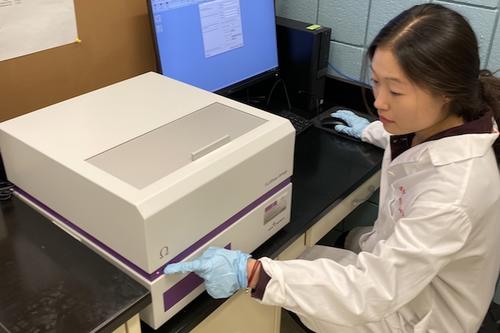
The team of University of Minnesota researchers developing a faster diagnostic test for identifying the misfolded prions associated with Chronic Wasting Disease (CWD) has reached a key milestone. Through their collaboration with National Institutes of Health Rocky Mountain Laboratories (Hamilton, Mont.), the team now has RT-QuIC technology that will facilitate a number of exciting research avenues. With this technology, the team analyzed tissue samples from CWD-positive white-tailed deer and obtained confirmation of protein-misfolding within nine hours.
“We were working with known positive samples,” explains team co-leader Peter Larsen, Ph.D., an assistant professor in the Department of Biomedical and Veterinary Sciences in the University’s College of Veterinary Medicine. “To independently confirm that our procedures are successful is a critical first step and we greatly appreciate the help that NIH Rocky Mountain Labs provided our team. This milestone was made possible through Rapid Agricultural Response funds from the Minnesota Ag Experiment Station and bipartisan support from the Minnesota Legislature.” The team is working to develop prototypes of more rapid and accurate tests that will identify CWD-causing prions in various kinds of samples.
RT-QuIC stands for Real-time Quaking-induced Conversion. It is a highly sensitive test for detecting prion diseases such as CWD, scrapie in sheep, bovine spongiform encephalopathy in cattle, and sporadic Creutzfeldt-Jakob disease in humans. The test involves placing suspected misfolded prions in a prion-rich solution, shaking and incubating the mixture to promote molecular interaction, and then monitoring for growth of misfolded prions. RT-QuIC has proven useful to detect CWD prions in a variety of sample types from both live and harvested deer, including feces, blood, saliva and tissues. At present, RT-QuIC is only used for research purposes. It has not been validated for official, regulatory disease diagnostic testing in wild or farmed cervids.
“Achieving a statistically positive result within hours demonstrates the advantages of this newer technology,” Larsen says. “The ultimate long-term goal for CWD diagnostics is the availability of next-generation diagnostic tools that can quickly and reliably process many samples. RT-QuIC functionality helps provide the foundation for developing and validating prototypes of a new class of CWD diagnostic tools.” More common, currently validated diagnostic methods are slower and more costly, which in the case of CWD, limits hunters and resource managers from making the timely decisions needed to contain the disease. In the future, RT-QuIC and further developed tests may be validated by regulatory agencies such as the United States Department of Agriculture and be available for official disease diagnostic testing.
This milestone places the U of M team among an elite community of research laboratories around the world that use RT-QuIC for both wildlife and human diseases. The U of M team is funded by approximately $2 million, awarded through the Minnesota Agricultural Experiment Station Rapid Agricultural Response Fund and appropriated by the Minnesota Legislature via the Legislative Citizens Commission on Minnesota Resources in 2019.
After further in-house validation of the RT-QuIC testing, the U of M team will turn its attention to analyzing tissue samples from approximately 500 deer that were generously provided by the Minnesota Department of Natural Resources. Previous testing by currently validated methods has found 12 CWD-positive samples within the collection. Confirming whether RT-QuIC can correctly identify the positive samples is the team’s next step. Further research initiatives include utilizing the RT-QuIC testing capabilities for environmental testing, transmission studies and ecological impact investigation.
FAQs
-
Will the RT-QuIC testing be available for hunter harvested and farmed cervid samples?
No. At this time, RT-QuIC is used for research purposes only. Diagnostic tests for CWD, other than those currently being used by state and federal agencies, must go through a validation process by those state and federal agencies. -
Will next-generation CWD tests be available to use by the public and/or regulatory agencies in two years?
No. Current research to develop new CWD tests is projected to deliver a prototype of the technology during the two-year funded process. Further time and resources will be necessary to enhance the prototype as well as fully validate the new testing platform for state and federal agency use. -
What is the future of CWD testing?
Ultimately, we intend to deliver a prototype of a next-generation CWD test. Further time and resources will be necessary to enhance the prototype and fully validate the new testing platform for state and federal agency use. -
Is RT-QuIC useful as both a live animal test and test for hunter-harvested deer?
Yes, other laboratories have used the technology to identify CWD prions in a wide variety of samples, including blood and saliva from live deer and lymph nodes and brain stems from harvested deer. -
Are RT-QuIC and anticipated future testing platforms only for CWD?
No. RT-QuIC is currently used for detecting other prion and protein misfolding diseases. Future platforms are likely to advance diagnostic testing across the spectrum of neurodegenerative diseases in humans and animals. -
Is it beneficial for the U of M to invest in RT-QuIC and further develop diagnostic platforms if other research institutions are also?
Yes. The fact that multiple research groups across the world are working on similar projects supports the line of research and strengthens the end product(s). The U of M is a comprehensive research university with a diverse realm of expertise. The diagnostic R&D team spans multiple colleges across the U of M, and is leveraging state-of-the-art research facilities to support these activities.
- Categories:
- Health




